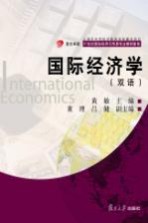图书介绍
国际经济学 双语【2025|PDF下载-Epub版本|mobi电子书|kindle百度云盘下载】

- 黄敏主编;董理,吕健副主编 著
- 出版社: 上海:复旦大学出版社
- ISBN:9787309080544
- 出版时间:2011
- 标注页数:271页
- 文件大小:10MB
- 文件页数:284页
- 主题词:国际经济学-双语教学-高等学校-教材-汉、英
PDF下载
下载说明
国际经济学 双语PDF格式电子书版下载
下载的文件为RAR压缩包。需要使用解压软件进行解压得到PDF格式图书。建议使用BT下载工具Free Download Manager进行下载,简称FDM(免费,没有广告,支持多平台)。本站资源全部打包为BT种子。所以需要使用专业的BT下载软件进行下载。如BitComet qBittorrent uTorrent等BT下载工具。迅雷目前由于本站不是热门资源。不推荐使用!后期资源热门了。安装了迅雷也可以迅雷进行下载!
(文件页数 要大于 标注页数,上中下等多册电子书除外)
注意:本站所有压缩包均有解压码: 点击下载压缩包解压工具
图书目录
Chapter 1 Classical Theories of International Trade1
1.1 Mercantilism2
1.2 Trade Based on Absolute Advantage:Adam Smith3
1.3 Trade Based on Comparative Advantage:David Ricardo4
1.3.1 An Example of Comparative Advantage5
1.3.2 Gains from Specialization and Trade with Comparative Advantage6
1.3.3 Comparative Advantage in Money Terms7
1.4 Comparative Advantage and Opportunity Cost8
1.4.1 Gains from Specialization and Trade with Opportunity Costs9
1.4.2 Production Possibilities Frontier and Constant Opportunity Costs11
1.4.3 Trade under Increasing Opportunity Costs19
1.5 Comparative Advantage with More Than Two Commodities and Countries23
1.5.1 Comparative Advantage with More Than Two Commodities23
1.5.2 Comparative Advantage with More Than Two Countries25
1.6 Theory of Reciprocal Demand25
1.7 Offer Curve and Terms of Trade28
1.7.1 Offer Curve28
1.7.2 Equilibrium Terms of Trade31
1.7.3 Other Concepts of the Terms of Trade37
Chapter 2 New Classical Theories of International Trade39
2.1 Specific Factor Model40
2.2 Factor Endowment Theory(H-O Model)42
2.3 Other New Classical Theories47
2.3.1 Rybczynski Theorem47
2.3.2 Factor Price Equalization Theory48
2.3.3 Stolper-Samuelson Theorem50
2.3.4 Explaining Wage Inequality51
2.4 Leontief Paradox53
Chapter 3 Modern Trade Theories58
3.1 Existence of Intraindustry Trade59
3.2 Technological Gap,Product Life Cycle and International Trade62
3.2.1 Technological Gap Theory63
3.2.2 Product Life Cycle Theory65
3.3 Theory of Overlapping Demands68
3.4 Economies of Scale,Imperfect Competition,and International Trade69
3.4.1 Economies of Scale and International Trade70
3.4.2 Monopolistic Competition and Trade74
3.5 Reciprocal Dumping Model87
3.5.1 Economics of Dumping87
3.5.2 Reciprocal Dumping90
Chapter 4 Tariffs and Nontariff Barriers92
4.1 Theories for Trade Protection93
4.1.1 Infant Industry Argument93
4.1.2 Terms of Trade Argument94
4.1.3 Domestic Market Failure Argument94
4.1.4 Strategic Trade Policy95
4.2 Tariffs96
4.2.1 Types of Tariffs97
4.2.2 Effective Rate of Protection100
4.2.3 Tariff Welfare Effects104
4.3 Nontariff Trade Barriers117
4.3.1 An Introduction to Nontariff Trade Barriers117
4.3.2 Effects of Import Quota123
4.3.3 Effects of Export Subsidy127
Chapter 5 Regional Trading Arrangements129
5.1 Types of Regional Trading Arrangements130
5.2 Effects of Customs Union132
5.2.1 Static Effects132
5.2.2 Dynamic Effects136
5.3 Practice of Regional Integration138
5.3.1 European Union138
5.3.2 North American Free Trade Agreement141
5.3.3 Association of Southeast Asian Nations143
Chapter 6 Balance of Payments and Foreign Exchange145
6.1 Balance of Payments146
6.1.1 Current Account147
6.1.2 Capital and Financial Account148
6.1.3 Automatic Adjustment of the Balance of Payments149
6.2 Foreign Exchange Market and Exchange Rates151
6.2.1 Foreign Exchange Market151
6.2.2 Exchange Rate152
6.2.3 Determinants of Exchange Rates154
6.3 Exchange Rate System156
Chapter 7 Theories of Exchange Rate Determination158
7.1 Theory of Purchasing Power Parity159
7.1.1 Absolute Purchasing Power Parity160
7.1.2 Relative Purchasing Power Parity161
7.2 Theory of Interest Rate Parity162
7.2.1 Covered Interest Rate Parity162
7.2.2 Uncovered Interest Rate Parity163
7.3 Balance of Payments Approach to Exchange Rates164
7.4 Asset Market Approach to Exchange Rates166
7.4.1 Flexible-Price Monetary Approach167
7.4.2 Sticky-Price Monetary Approach170
7.4.3 Portfolio Approach to Exchange Rates171
Chapter 8 Balance of Payments Adjustments176
8.1 Elasticities Approach to the Balance of Payments177
8.2 Multiplier Approach to the Balance of Payments187
8.3 Absorption Approach to the Balance of Payments189
8.4 Monetary Approach to the Balance of Payments193
8.4.1 A Change in Domestic Credit under Fixed Exchange Rates196
8.4.2 A Change in the Quantity of Money Demanded under Fixed Exchange Rates198
8.4.3 A Change in Domestic Credit under Floating Exchange Rates199
8.4.4 A Change in the Quantity of Money Demanded under Floating Exchange Rates199
Chapter 9 Macroeconomic Policies in Open Economy201
9.1 Internal Balance and External Balance in Open Economy202
9.1.1 Internal Balance and External Balance202
9.1.2 Policy Instruments203
9.1.3 Tinbergen Rule203
9.1.4 Meade Conflict204
9.2 Policy Mix to Achieve Both Internal Balance and External Balance204
9.2.1 Mundell Assignment Rule204
9.2.2 Swan Model207
9.3 Effects of Macroeconomic Policies under Fixed Exchange Rates208
9.3.1 IS-LM-BP Model208
9.3.2 Effects of Fiscal Policy under Fixed Exchange Rates210
9.3.3 Effects of Monetary Policy under Fixed Exchange Rates215
9.4 Effects of Macroeconomic Policies under Floating Exchange Rates217
9.4.1 Effects of Fiscal Policy under Floating Exchange Rates218
9.4.2 Effects of Monetary Policy under Floating Exchange Rates222
9.4.3 Mundell Incompatible Trinity224
Chapter 10 International Transmission and Coordination of Macroeconomic Policies226
10.1 International Transmission of Macroeconomic Policies under Fixed Exchange Rates227
10.1.1 Two-Nation Mundell-Fleming Model227
10.1.2 International Transmission of Fiscal Policy under Fixed Exchange Rates228
10.1.3 International Transmission of Monetary Policy under Fixed Exchange Rates230
10.2 International Transmission of Macroeconomic Policies under Floating Exchange Rates232
10.2.1 Intemational Transmission of Fiscal Policy under Floating Exchange Rates232
10.2.2 International Transmission of Monetary Policy under Floating Exchange Rates233
10.3 International Transmission of Inflation236
10.3.1 Price Adjustment Mechanism of Inflation Transmission236
10.3.2 Balance of Payments Mechanism of Inflation Transmission237
10.3.3 Interest Rate Transmission Mechanism238
10.4 International Policy Coordination and Monetary Cooperation238
10.4.1 International Coordination of Macroeconomic Policies239
10.4.2 International Monetary Cooperation241
Chapter 11 International Factor Movements and Multinational Enterprises243
11.1 International Movement of Labor244
11.1.1 Motives for International Labor Movement245
11.1.2 Economic Effects of Labor Movement246
11.1.3 Other Welfare Effects of International Labor Movement249
11.2 International Movement of Capital251
11.2.1 Data on International Movement of Capital252
11.2.2 Motives for International Capital Movement254
11.2.3 Economic Effects of Capital Movement256
11.3 Multinational Enterprises and Foreign Direct Investment Theories259
11.3.1 Multinational Enterprises259
11.3.2 Foreign Direct Investment Theories264
参考文献270
热门推荐
- 2519010.html
- 3086554.html
- 2375430.html
- 1215353.html
- 2412384.html
- 552727.html
- 1916655.html
- 1612688.html
- 448960.html
- 1815387.html
- http://www.ickdjs.cc/book_639798.html
- http://www.ickdjs.cc/book_3702831.html
- http://www.ickdjs.cc/book_239201.html
- http://www.ickdjs.cc/book_1719767.html
- http://www.ickdjs.cc/book_3618510.html
- http://www.ickdjs.cc/book_1025661.html
- http://www.ickdjs.cc/book_2515427.html
- http://www.ickdjs.cc/book_2337885.html
- http://www.ickdjs.cc/book_2124079.html
- http://www.ickdjs.cc/book_3566182.html